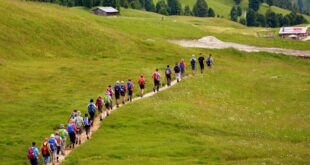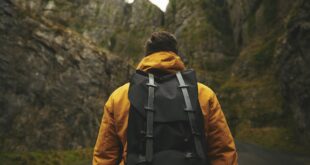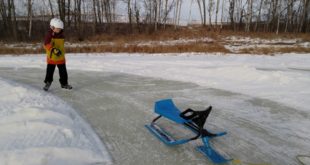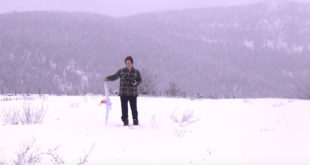As the summer hiking season draws to a close I’ve been starting my research for a group hike of the John Muir Trail next summer (hashtag #JMT2013 on twitter). In my research I came a cross a group that is receiving a lot of press right now, The Muir Project. They hiked the John Muir Trail back in 2011, documenting their experience and producing a video that looks absolutely amazing titled, “MILE, MILE & A HALF”. They’re working on a kickstarter project to help fund their film and I got a chance to ask them some questions about their experience.
Take a look at the trailer, and read on below to get a taste for their experience and a boost of motivation to get out and see some of the amazing things out there.
Q&A with the “The Muir Project” Team
So, for those who may not of heard of the Muir Project, Could you explain in a sentence please?
The Muir Project is a team of artists that left their daily lives to hike the John Muir Trail (219 miles in 25 days) & brought it back to share – currently taking the form of a feature-length documentary, Mile… Mile & A Half.
What drew you all to the trail in the first place?
Jason was definitely the initial catalyst for the project. He’s a native Californian and I think it’s always been on his list of things to do before he dies. As the years passed, we continued talking about hiking the trail in its entirety and bringing our cameras along. Jobs, children & prior commitments in one form or another forced us to put if off year after year, but we finally made the commitment to do it. Ultimately, it was always missing that extra “something” to make the time and the film worthwhile. But as others became attached to the project, the artistry angle seemed to fall in place, and we couldn’t NOT do it.
What did you hope to accomplish by hiking the trail?
We have to be honest. Our #1 priority was completing the trail. In a 200%+ snow year, along a trail that features 70,000+ elevation change, with an extra 20+ pounds of gear each, successfully finishing the trail was a challenge. Beyond that, our hope was to create an interactive exhibition to allow others to experience the trail. But when we returned home, and realized the footage – and more importantly the story – we had, we switched gears and focused on the documentary.
PREPARATION
What resources did you use for planning and which would you recommend?
We had Elizabeth Wenk’s “John Muir Trail: The Essential Guide to Hiking America’s Most Famous Trail” along with topo maps. For Food resource, TrailCooking.com is great. There is a ton of information on the internet as well, filled with other people’s experiences and recommendations. I don’t think you can have TOO much information. In the end, you have to go with what you feel is right, but the more details the better. That goes for on the trail as well. Talk to rangers and fellow hikers to get their report so you can assess the best routes to take.
Jason: There’s also the John Muir Trail Yahoo Group. They’re incredibly knowledgeable and helpful to people who want to hike the trail. I wish we would have known about it before we set out.
How much time did you need to do all the prep work?
We started 6 months in advance to get permits in place and test gear for the trip. Three months before we started the real work – prepping food, gear, etc., group camping trips, and detailing our daily miles to set-up cache drops along the way.
What turned out to be the most important part of the planning?
Durand: The food prep for sure.
Jen: I’ll have to say making sure that our 3.5 –year-old, Isola, was was all set for her trip to visit grandparents. She was able to travel between 2 sets of grandparents and cousins homes, so it was an adventure whenever we had cell reception to try and connect with her.
Did you do much training before you hit the trail?
Most of us had peak-bagged Whitney before, and for that we trained a ton. For this trip, we tried to increase cardio, and make sure boots and packs were broken in before hitting the trail. But in all best laid plans, something always goes awry.
Jason: We also did a test trip up in the mountains above Ojai. It was a pretty good climb up there, and it was a good chance to test our gear, legs and lungs.
3 Weeks on the trail is about 10 miles a day. Would you plan for more or less miles next time?
The mileage itself was completely fine; once you get to the tougher passes, your body is ready for them. But as we were documenting the process, we all would’ve loved a few days to stay and document a 24-hour cycle of some of these amazing locations. Oh, and an extra day at Muir Trail Ranch wouldn’t hurt either.
How did you get to the trailhead?
Zee Hatley’s father, Martin Hatley, drove us up in his truck. It’s a trail that Martin has always wanted to attempt, so it was pretty special that he could be there to see us all off.
Jason: Also, a couple of us were driven up by our producer Kia Kiso.
North to South or South to North?
North to South
As a group, the JMT2013 community is trying to decide on which side trips to hit along the way, but we only have 2 weeks to do it. Any ones worth or not worth the time?
Rae Lakes loop is a beauty.
Ric: Palisade Lakes was particularly amazing for me. I definitely want to return.
Weight is a factor as always, but something always gets left behind any gear you should have brought that you didn’t or that you feel you should have left behind?
Going North to South, you stop through populated areas early-on so you can drop gear if need be. Jen sent back her 2nd pair of pants, but that was it. We used it all. As for more gear, no photographer would ever begrudge an extra lens.
How were the bears? Any tips on bear vaults?
We saw 3 bears along the way, most several hundred feet away. Tips for the bear vaults? Hmmm… if someone can figure out how to open them in the early morning, that’d be a tip worth hearing.
Durand: I learned that Bear vaults are also “Durand-proof”. If you don’t want to experience a daily battle of wits with an inanimate object, I would recommend breaking it in before heading out. Alas, no amount of compassionate reasoning followed by endless streams of profanity will break the will of that treacherous blue beast.
I hear there isn’t a lot of rain up there in summer, was that your experience?
We experienced rain for about a 4-day stretch on the trail. The first day was the most nerve-racking, as there were lightning strikes and hail, as we headed over Pinchot Pass. A day hiker remarked as we were rushing past them. “You JMT hikers are crazy. You’ll hike through anything.” Kinda funny, since that’s what we thought about PCT hikers. Now those guys are tough.
Jason: Actually, afternoon summer thunderstorms are pretty common in the High Sierras. We got hailed on, and that’s not the first time that’s happened to me. The positive of the storms is usually you get a pretty sweet rainbow or three afterwards. It’s good to bring at the very least a lightweight rain cover.
I don’t want to carry more water than I need to but I usually go through a lot on the trail. How often do you come across water sources?
200%+ sow year meant LOTS and LOTS of water. Creeks were rushing rivers, and 2 girls ahead of us were even helivacked out after being washed down stream. So, it’s difficult for us to comment on a normal year, as we were changing into water shoes 2-3 times/day.
Jason: You would be surprised how far you can go between water sources sometimes. I would always error on the side of caution with that. Hikers coming from the opposite direction can be a good source of information on where the next water source is.
As far as purifying goes, did you filter, chemical or straight from the crystal clear?
We filtered.
Zee: Even Jason, who had planned on drinking straight from the mountain tap. I had a steripen.
Jason: I’m more cavalier than the others about drinking from the streams, but I am somewhat careful. When you’re high up and you see the water coming straight from the glacier I’m fine with it. At lower elevations or heavily trafficked spots like the Yosemite or the Whitney Zone I stick to filtered water.
How did you handle batteries and recharging on the trail?
We had friends meet us along the trail – at Devil’s Postpile and Muir Trail Ranch – with laptops and sources for us to recharge and dump all of our media. We also had a Goal Zero Sherpa solar panel with us for the long stretches when we didn’t see people.
R and R
What was the best way to unwind after a day of hiking?
Well, for us, not hiking meant shooting more and cleaning gear, but when the musicians joined our group, we at least got to share in the great sounds they were making. (And a little whiskey didn’t hurt either.)
Durand: If you’re near a lake or a river, the best way that I find to unwind is by making the plunge. Sometimes it takes a little liquid courage, but you always feel better afterwards and it also serves to ice your joints, even if just for a few minutes.
How are the listed re-supply points?
It’s actually a huge leap of faith to believe that your food stashes will be where you put them 1 month prior, or that a mule and you will arrive at the same designated time several weeks later, but for us it all worked out. A few of our drops got switched around so some of us were without some food, but with a large group, we were able to make do.
Something I’ve been thinking about is varying pace of hikers. What’s the ideal group size? Did you stick together the whole time?
In the beginning we were all at varied paces, but by the end we had adjusted to where you were generally hiking somewhat together or at least in pairs. But as always, you often find yourself somewhat isolated, which is really not a bad thing, either.
With the water crossings, snow and rock scrambling, we were often together to figure out technical aspects, and sometimes just to locate the trail. Otherwise, we would just regroup at a junction or any sketchy section of the trail.
3 weeks on the trail eating Freeze dried can put your tongue to the test, any memorable meals (deliciously or nortoriously)?
Deconstructed Pizza and Triple Potatoes were clearly the group favorites. There was a less than desirable Orange Quinoa dish that would need considerable work before it came back on the trail. There wasn’t time to actually test out the dishes so they were all based on a “Huh, that sounds good” approach and then Jen usually added more freeze-dried veggies to the mix.
Any food tips for next year?
Bulk is good. Mary Jane’s Farm makes some awesome food that you can buy in bulk, and definitely check out the grocery stores. They have a ton of preserved foods. (Perhaps a sad commentary on our eating habits, but a great resource for the trail.)
Was the scenery what you expected?
Jen: Personally, I was blown away by Kings Canyon National Park. Yosemite and Sequoia are the National Parks you hear spoken of, and the variety in Kings Canyon was pretty spectacular.
Durand: Having spent a good deal of time in the Sierras I thought I had a pretty good idea of what I would see when we began. I couldn’t have been more offbase. No matter how many pictures you see, experiencing the visuals in the backcountry is literally breathtaking. You’ll remember not just the sights, but also the sounds and emotions from each particular place.
Jason: I had probably hiked a good quarter of the trail in several different areas, so even having been to a lot of these places the snow really added a breathtaking grandeur to what I had remembered and expected.
I’m sure you all took something away from the time on the trail. Does it make you want to do the JMT again or maybe something different?
Jen: I’m always ready for “what’s next?”
Zee: I’ve been taking an active effort to be more active generally. Taken up running, participating in mudruns and long distance relays. The Sierras are home, but you can’t stay home all the time.
Ric: BOTH!
Durand: I would love to do the JMT again, but I also want to get out there and explore new territory. The Te Araroa trail in New Zealand looks very, very tempting.
Jason: Yeah, I’m with the other on the Both. There’s so many amazing places I haven’t seen, but the JMT certainly has a special place in my heart and I’d like to do it again after I’ve ticked off another couple of things on my wish list.
Any tips for people who find themselves spending more time reading about the outdoors then actually getting out and enjoying them?
There’s never enough time, and the To Do list will always be there. And if you make it out, you’ll have those amazing memories to draw on forever. Get it on you calendar. Now.
Ric: New terrain can be intimidating (both geographically and experientially), so just take small steps. They’ll still get you where you want to go.
Zee: Now they’ll have a movie to watch on top of all the reading. 😉 But really we hope it’ll rouse you to push yourself out the door.
Durand: The hardest part is just getting out there. You need to set a date and stick to it. Once you get out on the trail, wherever that may be, I can assure you that you will not regret it.
Any last words?
Our greatest hope with this project is to inspire others to get out have their own adventure. Here’s hoping…
Trailer 2:
MILE… MILE & A HALF (trailer 2) from The Muir Project on Vimeo.
P.S. If you want to support their kickstarter project, just click here to find out how.
 The Outdoor Adventure Giving you tips, tricks & recommendations to help make adventuring in the Outdoors fun, safe & exciting for you and your kids.
The Outdoor Adventure Giving you tips, tricks & recommendations to help make adventuring in the Outdoors fun, safe & exciting for you and your kids.









